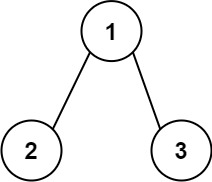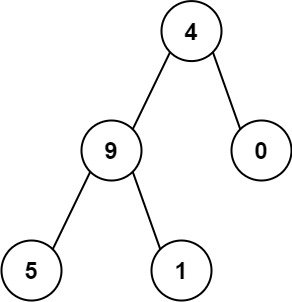You are given the root of a binary tree containing digits from 0 to 9 only.
Each root-to-leaf path in the tree represents a number.
- For example, the root-to-leaf path
1 -> 2 -> 3represents the number123.
Return the total sum of all root-to-leaf numbers. Test cases are generated so that the answer will fit in a 32-bit integer.
A leaf node is a node with no children.
Example 1:

Input: root = [1,2,3] Output: 25 Explanation: The root-to-leaf path1->2represents the number12. The root-to-leaf path1->3represents the number13. Therefore, sum = 12 + 13 =25.
Example 2:

Input: root = [4,9,0,5,1] Output: 1026 Explanation: The root-to-leaf path4->9->5represents the number 495. The root-to-leaf path4->9->1represents the number 491. The root-to-leaf path4->0represents the number 40. Therefore, sum = 495 + 491 + 40 =1026.
Constraints:
- The number of nodes in the tree is in the range
[1, 1000]. 0 <= Node.val <= 9- The depth of the tree will not exceed
10.
Approach 01:
-
C++
-
Python
#include <bits/stdc++.h>
using namespace std;
struct TreeNode {
int val;
TreeNode *left;
TreeNode *right;
TreeNode() : val(0), left(nullptr), right(nullptr) {}
TreeNode(int x) : val(x), left(nullptr), right(nullptr) {}
TreeNode(int x, TreeNode *left, TreeNode *right) : val(x), left(left), right(right) {}
};
class Solution {
public:
int solve(TreeNode* root,int current){
if(!root){
return 0;
}
current = (current*10) + root->val;
if(root->left == NULL && root->right == NULL){
return current;
}
int left = solve(root->left, current);
int right = solve(root->right, current);
return (left + right);
}
int sumNumbers(TreeNode* root) {
return solve(root, 0);
}
};
from typing import *
class TreeNode:
def __init__(self, val=0, left=None, right=None):
self.val = val
self.left = left
self.right = right
class Solution:
def solve(self, root, current):
if(root == None):
return 0
current = current*10 + root.val
if(root.left == None and root.right == None):
return current
left = self.solve(root.left, current)
right = self.solve(root.right, current)
return (left + right)
def sumNumbers(self, root: Optional[TreeNode]) -> int:
result = self.solve(root, 0)
return result
Time Complexity
- Recursive Traversal:
The
sumNumbersfunction callssolverecursively on each node of the tree. Each node is visited once. - Overall Time Complexity:
The overall time complexity is \( O(n) \), where \( n \) is the number of nodes in the binary tree. This is because each node is visited exactly once.
Space Complexity
- Recursive Stack Space:
The space complexity is determined by the maximum depth of the recursion stack. In the worst case, this depth is equal to the height of the tree.
- Overall Space Complexity:
The overall space complexity is \( O(h) \), where \( h \) is the height of the binary tree. In the worst case, for a skewed tree, the space complexity can be \( O(n) \). For a balanced tree, the space complexity will be \( O(\log n) \).